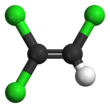Trichlorethylene
 |
|||
|
|
|||
| Names | |||
|---|---|---|---|
|
IUPAC name
trichloroethene
|
|||
| Other names
1,1,2-Trichloroethene,
1,1-Dichloro-2-Chloroethylene, 1-Chloro-2,2-Dichloroethylene, Acetylene Trichloride, TCE, Trethylene, Triclene, Tri, Trimar, Trilene, HCC-1120 |
|||
| Identifiers | |||
|
3D model (JSmol)
|
|||
| Abbreviations | TCE | ||
| ChEBI | |||
| ChemSpider | |||
| ECHA InfoCard | 100.001.062 | ||
| EC Number | 201-61-04 | ||
| KEGG | |||
|
PubChem CID
|
|||
| RTECS number | KX4550000 | ||
| UNII | |||
|
|||
|
|||
| Properties | |||
| C2HCl3 | |||
| Molar mass | 131.4 g/mol | ||
| Appearance | Colorless liquid | ||
| Odor | chloroform-like | ||
| Density | 1.46 g/cm3 (20 °C) | ||
| Melting point | −84.8 °C (−120.6 °F; 188.3 K) | ||
| Boiling point | 87.2 °C (189.0 °F; 360.3 K) | ||
| 1.280 g/L | |||
| Solubility | ether, ethanol, chloroform | ||
| Vapor pressure | 58 mmHg/0.076 atm (20°C) | ||
| -65.8·10−6 cm3/mol | |||
|
Refractive index (nD)
|
1.4777 at 19.8 °C | ||
| Pharmacology | |||
| N01AB05 (WHO) | |||
| Hazards | |||
| Main hazards | Harmful if swallowed or inhaled, carcinogenic | ||
| Safety data sheet |
See: data page Mallinckrodt Baker |
||
| NFPA 704 | |||
| 420 °C (788 °F; 693 K) | |||
| Explosive limits | 8%-10.5% | ||
| Lethal dose or concentration (LD, LC): | |||
|
LC50 (median concentration)
|
8450 ppm (mouse, 4 hr) 26300 (rat, 1 hr) |
||
|
LCLo (lowest published)
|
2900 ppm (human) 37,200 ppm (guinea pig, 40 min) 5952 ppm (cat, 2 hr) 8000 ppm (rat, 4 hr) 11,000 (rabbit) |
||
| US health exposure limits (NIOSH): | |||
|
PEL (Permissible)
|
TWA 100 ppm C 200 ppm 300 ppm (5-minute maximum peak in any 2 hours) | ||
|
REL (Recommended)
|
Ca | ||
|
IDLH (Immediate danger)
|
Ca [1000 ppm] | ||
| Related compounds | |||
|
Related vinyl halide
|
vinyl chloride | ||
|
Related compounds
|
chloroform 1,1,1-Trichloroethane 1,1,2-Trichloroethane |
||
| Supplementary data page | |||
|
Refractive index (n), Dielectric constant (εr), etc. |
|||
|
Thermodynamic
data |
Phase behaviour solid–liquid–gas |
||
| UV, IR, NMR, MS | |||
|
Except where otherwise noted, data are given for materials in their standard state (at 25 °C [77 °F], 100 kPa).
|
|||
|
|
|||
| Infobox references | |||
The chemical compound trichloroethylene is a halocarbon commonly used as an industrial solvent. It is a clear non-flammable liquid with a sweet smell. It should not be confused with the similar 1,1,1-trichloroethane, which is commonly known as chlorothene.
The IUPAC name is trichloroethene. Industrial abbreviations include TCE, trichlor, Trike, Tricky and tri. It has been sold under a variety of trade names. Under the trade names Trimar and Trilene, trichloroethylene was used as a volatile anesthetic and as an inhaled obstetrical analgesic in millions of patients.
Groundwater and drinking water contamination from industrial discharge is a major concern for human health and has precipitated numerous incidents and lawsuits.
Pioneered by Imperial Chemical Industries in Britain, its development was hailed as an anesthetic revolution. Originally thought to possess less hepatotoxicity than chloroform, and without the unpleasant pungency and flammability of ether, TCE use was nonetheless soon found to have several pitfalls. These included promotion of cardiac arrhythmias, low volatility and high solubility preventing quick anesthetic induction, reactions with soda lime used in carbon dioxide absorbing systems, prolonged neurologic dysfunction when used with soda lime, and evidence of hepatotoxicity as had been found with chloroform.
The introduction of halothane in 1956 greatly diminished the use of TCE as a general anesthetic. TCE was still used as an inhalation analgesic in childbirth given by self-administration. Fetal toxicity and concerns for carcinogenic potential of TCE led to its abandonment in developed countries by the 1980s.
Due to concerns about its toxicity, the use of trichloroethylene in the food and pharmaceutical industries has been banned in much of the world since the 1970s. Legislation has forced the substitution of trichloroethylene in many processes in Europe as the chemical was classified as a carcinogen carrying an R45 risk phrase, May cause cancer. Many degreasing chemical alternatives are being promoted such as Ensolv and Leksol; however, each of these is based on n-propyl bromide which carries an R60 risk phrase of May impair fertility, and they would not be a legally acceptable substitute.
...
Wikipedia



